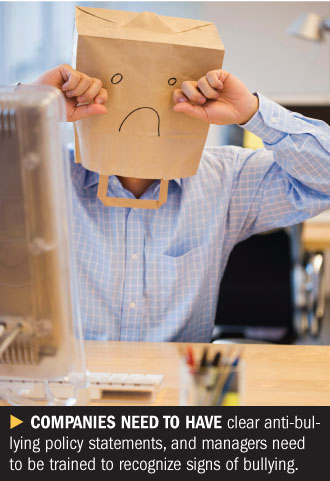National Underwriter P&C
April 11, 2011 By Susanne Sclafane, PropertyCasualty360.com“Status-blind harassment”—more commonly known as workplace bullying—is a growing concern to employers and their employment practices liability insurers. But while the costs of having bullies in the workplace are clear, appropriate steps to recognize and rein in the problem aren’t always obvious.

Experts use the term “status-blind” or “equal-opportunity harassment” to distinguish workplace bullying from harassment targeted at classes of workers protected under federal and state statutes.
“It’s the boss who abuses his or her power not because someone is a woman over the age of 40 or Hispanic, but rather because the boss wants to bully and is a bully—and anyone who gets in the way is going to be a victim of that bullying, says Gerald Maatman Jr., a partner of Seyfarth Shaw in Chicago.
While there are currently no statutes outlawing bullying, lawyers and EPLI experts note that at least 10 states are considering legislative proposals to do just that. Even in the absence of anti-bullying statutes, however, the experts say there are other consequences to consider, such as employee turnover and sick days.
Highlighting serious ramifications, Adeola Adele, EPLI product leader for Marsh’s FINPRO group in New York, says, “Workplace violence starts with bullying.” She cites a case where an individual shot his co-workers. “The back-story was that he was bullied at work, and no one listened.”
Aon Hewitt’s Adler says training managers “to be good at mitigating the risk of bullying does not just involve focusing on the bully’s behavior, but really [means] carefully gauging the emotional state of all their employees to get a sense of whether they are victims.”
More generally, he explains that risk mitigation in this area really involves two components: pre-hire assessment and performance management.
“There are things that can be done to assess perspective employees for the tendency to express anger, to be aggressive, to show excitability—all factors that can lead to bullying.”
What if bullying tendencies are revealed during the hiring process?
“It would be perfectly legitimate in my view not to hire somebody who poses a reasonable risk,” Adler says, noting that he speaks from the perspective of an organizational psychologist, not a lawyer. “Bullying can result in lawsuits, loss of talent, creating a hostile environment for employees that would cause them to leave,” he says.
What do you do if somebody is a reasonable risk and they’re already on board, or because of their talents you want to hire them?
• First, companies need to have clear policy statements, conveying clear expectations that bullying is not tolerated and there will be consequences.
• Second, managers need to be trained to recognize signs of bullying and to be responsive in taking action so they’re not contributing inadvertently to creating a hostile work environment.
Recognizing behaviors related to bullying has two sides to it—recognizing the behavior of the bully, and paying attention to the emotional states and behaviors of potential or actual victims, Adler says. He cites findings of a Canadian research study published last year in a leading psychology journal showing that bullying is more likely to impact a victim’s work performance than sexual harassment.
David Carlson, Midwest Zone Leader of Marsh Risk Consulting’s Workforce Strategies Practice, agrees there needs to be education around workplace bullying. Right now, he says, only “the progressive companies are going to go out and have bullying policies and training.”
“For the less progressive ones, where it may be more pervasive, it’s a command-and-control issue. They’re going to wait until they’re told by state and local authorities and regulators that they have to do this,” he says.
Carlson says that suspected occurrences of bullying need to be fully and carefully investigated, and like Adler, believes that once it is identified, “progressive disciplinary is typical for most organizations.” But depending on the severity of the activity, “it could be grounds for immediate termination,” he adds.
“That has to come down to the policies and culture of the workplace. Companies need to have a zero-tolerance policy for anything like workplace violence, workplace bullying or sexual harassment,” he says. “There needs to be swift and immediate action.


 Experts use the term “status-blind” or “equal-opportunity harassment” to distinguish workplace bullying from harassment targeted at classes of workers protected under federal and state statutes.
Experts use the term “status-blind” or “equal-opportunity harassment” to distinguish workplace bullying from harassment targeted at classes of workers protected under federal and state statutes.